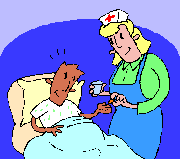Although the time may vary, most ophthalmologists have their patients fitted
six to eight weeks after surgery. Generally, if too much time passes before
the patient is fitted, the socket may begin to shrink and thus it becomes more
difficult to achieve a satisfactory cosmetic and functional result. If too
little time elapses, not enough healing has occurred to achieve a proper fit.
In most cases a conformer made of plastic or silicone is placed in the socket following surgery.
The conformer is placed to maintain orbit volume and to help form the cul-de-sacs (lid pockets) that will hold the eye
in place. The conformer should be left in at all times so that socket volume is not lost while
healing proceeds.
Do not rub your lids from the nose toward the side of your face, ( down and
outward motion). This may
dislodge the conformer or the prosthesis, when you start wearing it. Always
close your eye before you wipe, and do so toward
the nose in a horizontal direction.
If the conformer should slip out, wash it with soap and water, rinse
well and reinsert. If you should happen to lose the conformer, it is
important to get a replacement from your ocularist.
To insert the conformer or the prosthesis, after you wash your hands and
rinse them well, lift the upper lid with the thumb or forefinger of one
hand. Next, slide the conformer under the upper lid and, while holding
it in place, pull down on the lower lid. This allows the conformer to
slip into place in the socket. Click
here on this link to see how an artificial eye is inserted.
The conformer should be handled the same way.
Your ocularist may have a care sheet with photos regarding the insertion
and removal procedure.
It is likely that you will continue to tear from the socket. At times, tears and secretions
will build up behind the conformer and may release all at once. Do not be alarmed at this normal
event. Simply wipe the lids toward the nose with a tissue or warm wash cloth to remove the
secretions.
You can also use Johnson’s baby shampoo and Q-tips for cleaning dried secretions
from the lid margins. This problem will usually lessen once the prosthetic eye is fit and total
healing is completed. However, if any thick secretions or excessive tearing occur
consult your
ophthalmologist.

Make sure you continue to use any medications that your physician prescribes.
Some conformers have holes in them to enable the antibiotic ointment or drops to get into the
socket and the tears and secretions to drain out.
After a period of time following the surgery,
it will not be medically necessary to wear an eye bandage. However, if you wish to keep the
eye covered while it continues to heal, small flesh-colored eye patches called Opticlude made
by 3M Company can be used. Opticlude patches are available over the counter at
many pharmacies and are
usually found in the bandage section.
Opticlude patches
are less bulky and smaller than the medical bandage eye patches, contoured to
the face and they stick on and peel off easily. They are available in both
junior and adult sizes and because they’re thinner like a Band-Aid, glasses can
easily be worn over them. They are available at your drug store in the
first-aid department.
Home Page